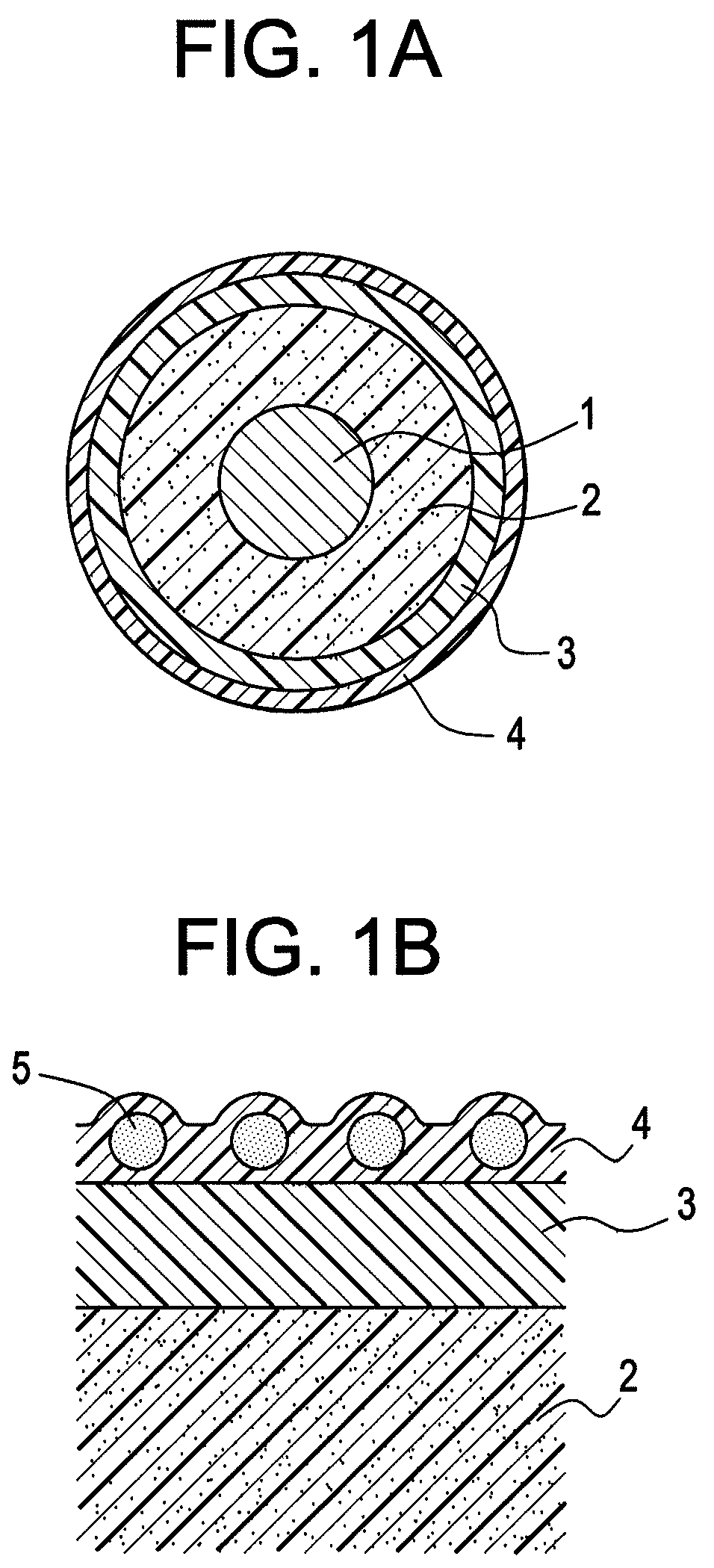Development roller
a technology of development rollers and rollers, which is applied in the direction of shafts and bearings, coatings, instruments, etc., can solve the problems of disadvantageous peeling of coating films, insufficient adhesion between elastic layers and coating films of water-based paints, and inability to achieve desired surface roughness of rollers to be finally obtained, etc., to achieve the effect of ensuring the hardness of the roller
- Summary
- Abstract
- Description
- Claims
- Application Information
AI Technical Summary
Benefits of technology
Problems solved by technology
Method used
Image
Examples
example 1
[0037]First of all, to the periphery of a core bar 1 (8 mm in diameter, 260 mm in length, material: sulfur free-cutting steel), a polyurethane foam was fixed by a mechanical froth method.
[0038]In particular, a polyurethane raw material containing 100 parts by weight of an isocyanate component (prepolymerized isocyanate TDI+polyol), 20 parts by weight of a polyol component (polyether polyol), 2 parts by weight of carbon black (acetylene black), and 0.2 parts by weight of an ion conductive agent (sodium perchlorate) was prepared and was then mechanically stirred while dry air was mixed with the polyurethane raw material, so that foaming was performed. This foamed polyurethane raw material was charged in a split metal mold having a cylindrical shape, the mold having holes at end portions thereof through which a shaft was held and having metal caps supporting the shaft. Inside the mold, the core bar 1 provided with an adhesive around the periphery thereof was placed. Subsequently, the m...
examples 2 to 5
[0040]Development rollers were formed in a manner similar to that in Example 1 except that the thickness of the underlying conductive layer 3 was set to 8, 10, 100, and 105 μm. The surface roughness of the rollers thus formed was in the range of 0.6 to 1.5 μm in terms of the arithmetic average roughness Ra in accordance with JIS.
example 6
[0041]A development roller was formed in a manner similar to that in Example 1 except that a water-based paint composed of 100 parts by weight of a chloroprene-methacrylic acid copolymer (trade name: Shoprene SRX-1412, manufactured by Showa Denko K. K.) and 3.5 parts by weight of carbon black (Ketjen black) blended therewith was applied as a first sublayer by dip coating onto the cured polyurethane foam removed from the mold to form a coating film having a thickness of 10 μm, and that as a second sublayer, dip coating of an acrylic emulsion containing carbon black (Ketjen black) was performed to form a coating film having a thickness of 50 μm so that the underlying conductive layer 3 was formed to have a total thickness of 60 μm. The surface roughness of the roller thus formed was 0.6 to 1.5 μm in terms of the arithmetic average roughness Ra in accordance with JIS.
PUM
 Login to View More
Login to View More Abstract
Description
Claims
Application Information
 Login to View More
Login to View More - R&D
- Intellectual Property
- Life Sciences
- Materials
- Tech Scout
- Unparalleled Data Quality
- Higher Quality Content
- 60% Fewer Hallucinations
Browse by: Latest US Patents, China's latest patents, Technical Efficacy Thesaurus, Application Domain, Technology Topic, Popular Technical Reports.
© 2025 PatSnap. All rights reserved.Legal|Privacy policy|Modern Slavery Act Transparency Statement|Sitemap|About US| Contact US: help@patsnap.com



